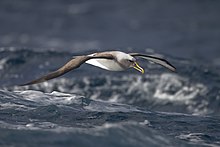Procellariiform
| Procellariiformes Temporal range: Eocene–Present Possible Cretaceous record |
|
|---|---|
 |
|
| Buller's albatross | |
| Scientific classification | |
| Kingdom: | Animalia |
| Phylum: | Chordata |
| Class: | Aves |
| Clade: | Austrodyptornithes |
| Order: |
Procellariiformes Fürbringer, 1888 |
| Families | |
|
†Diomedeoididae |
|
| Diversity | |
| 4 Families, 23 Genera, 125 Species | |
†Diomedeoididae
Procellariidae
Diomedeidae
Hydrobatidae
Oceanitidae
Pelecanoididae
Procellariiformes is an order of seabirds that comprises four families: the albatrosses, petrels and shearwaters, storm petrels, and diving petrels. Formerly called Tubinares and still called tubenoses in English, they are often referred to collectively as the petrels, a term that has been applied to all Procellariiformes, or more commonly all the families except the albatrosses. They are almost exclusively pelagic (feeding in the open ocean), and have a cosmopolitan distribution across the world's oceans, with the highest diversity being around New Zealand.
Procellariiformes are colonial, mostly nesting on remote, predator-free islands. The larger species nest on the surface, while most smaller species nest in natural cavities and burrows. They exhibit strong philopatry, returning to their natal colony to breed and returning to the same nesting site over many years. Procellariiformes are monogamous and form long-term pair bonds that are formed over several years and may last for the life of the pair. Only a single egg is laid per nesting attempt, and usually only a single nesting attempt is made per year, although the larger albatrosses may only nest once every two years. Both parents participate in incubation and chick rearing. Incubation times are long compared to other birds, as are fledging periods. Once a chick has fledged there is no further parental care.
...
Wikipedia
